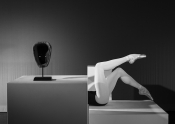The Language of Objects
The UB Art Galleries is pleased to announce the opening of The Language of Objects featuring artists Matthew Craven, Brendan Fernandes, and Alyssa Pheobus Mumtaz. On view from April 22 through July 30, 2017, this exhibition showcases three artists who appropriate cultural objects in their practice. A catalogue accompanies the exhibition, with texts by Katie Geha, Justine Ludwig, and Evan Moffitt.
Seven years after the installation of the Cravens Collection—a vast collection of archaeological and ethnographic objects on view in the gallery’s open storage room—the UB Art Galleries has initiated a new objective for the collection. In addition to the continued research by students, the galleries will enlist contemporary artists to engage the collection in multi-faceted ways. For this exhibition, each artist is working with a collection of objects, thereby, constructing new pathways that add to the object’s history. Philosopher Theodor Adorno argued that museums and mausoleums were within the same realm and that objects, once inside a museum, are removed from the flow of culture where new connections can be established. The artists in this exhibition dissuade this theory by continuing to spotlight new narratives through the varied connections with cultural objects and diverse artistic processes.
Matthew Craven sources his images from out of print textbooks that he collages on the backs of vintage movie posters. The work is analog; the artist purchases multiples of books in order to utilize the actual printed imagery instead of digital copies. His repetitive use of the object keeps the objects ever-present in his work. His sophisticated eye combines repeated imagery such as Greek vases, Roman busts, African wood carvings and Neolithic tools and sometimes incorporates them with hand-drawn patterns that exist across cultures and time periods. With many of the fundamental shapes he uses often unspecific to place, his collages are scattered across millennia, compressing time and allowing for diverse histories to intertwine.
Brendan Fernandes explores notions of identity relating to his unique cultural background as a Canadian artist of Kenyan and Indian descent. While often utilizing African objects that refer to notions of provenance and authenticity, Fernandes’ work also addresses the complex histories of these objects. For this exhibition, the artist will focus specifically on the African masks from the Cravens Collection, and use these objects to raise questions about their authenticity. As an artist, he is adopting museum techniques of display—installing the original objects on their mounts with documentary photographs of their backs, which refer to how masks are tested for authenticity by investigating the markings and secretions from past wearers. This exhibition will demonstrate his interest in the disembodied object. Included are photographs of dancers from the American Ballet Theatre interacting with the Cravens’ Collection masks in formal ballet poses. CNC-printed replicas of the masks will be worn by students from UB’s Department of Theatre & Dance who will perform in a new commissioned performance titled The Other Side.
Alyssa Pheobus Mumtaz’s work is influenced greatly by her personal connection and frequent travels to South Asia. Using archeology and the life of artifacts as a point of departure, Pheobus Mumtaz’s work is graphically focused and steeped in symbolism. The three series in this exhibition all confront the missing body in space. In Loom Drawings, the artist abstracts the loom into a flattened object, presenting it in various states of weaving and unraveling. The luminous prayer beads in Constellations are arranged in a series of graceful forms on hand-made paper, yet without the hands that hold them close. Finally in the Travelers series, what seem to be Asian-inspired dresses and robes composed onto handwoven tussar silk, float gently off the wall, suggesting the human body could fill the empty space.
Working in the undefined space between artist, archivist, and collector, Craven, Fernandes and Pheobus Mumtaz each present the complex lives of cultural objects and images that have infiltrated their oeuvres that continue to influence their practices.



